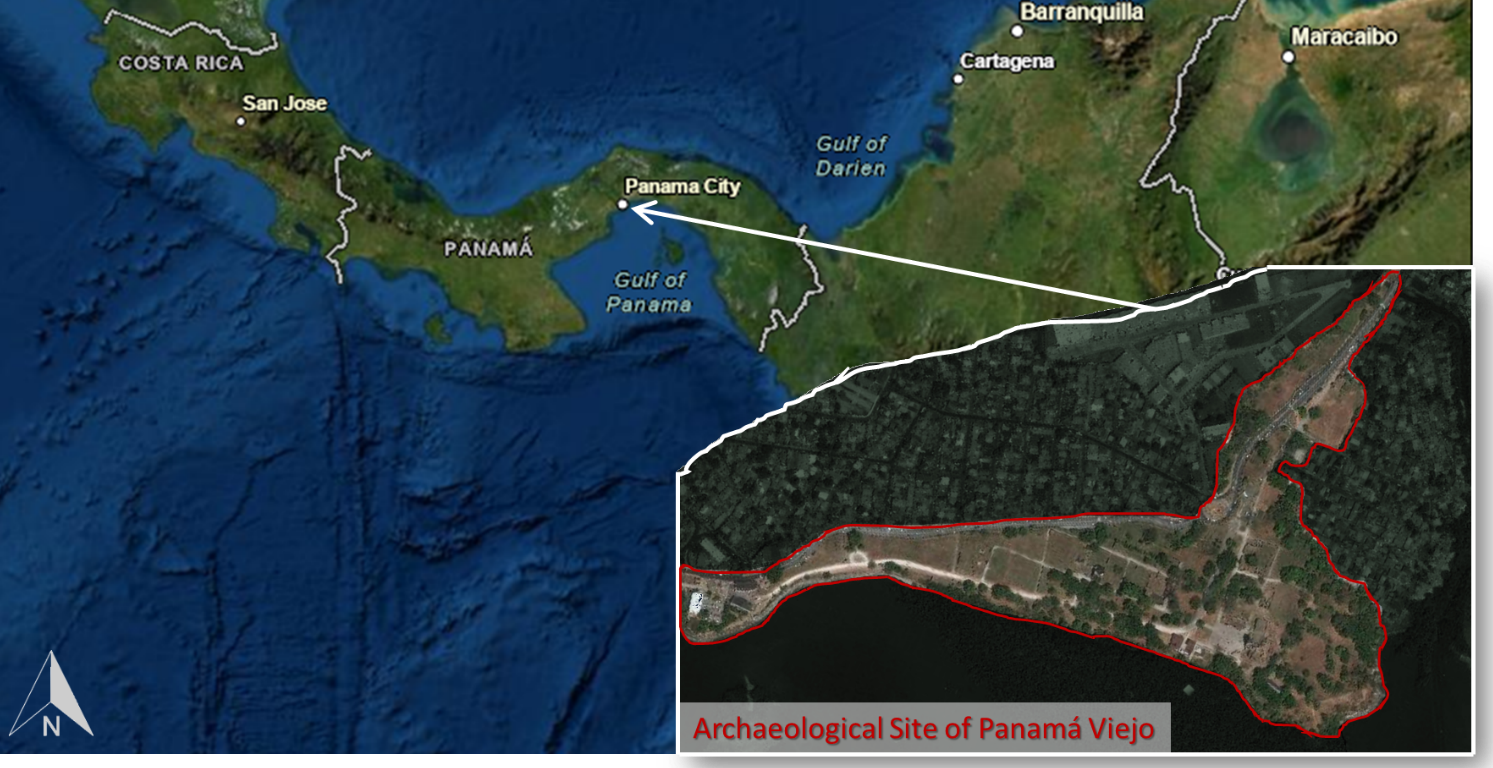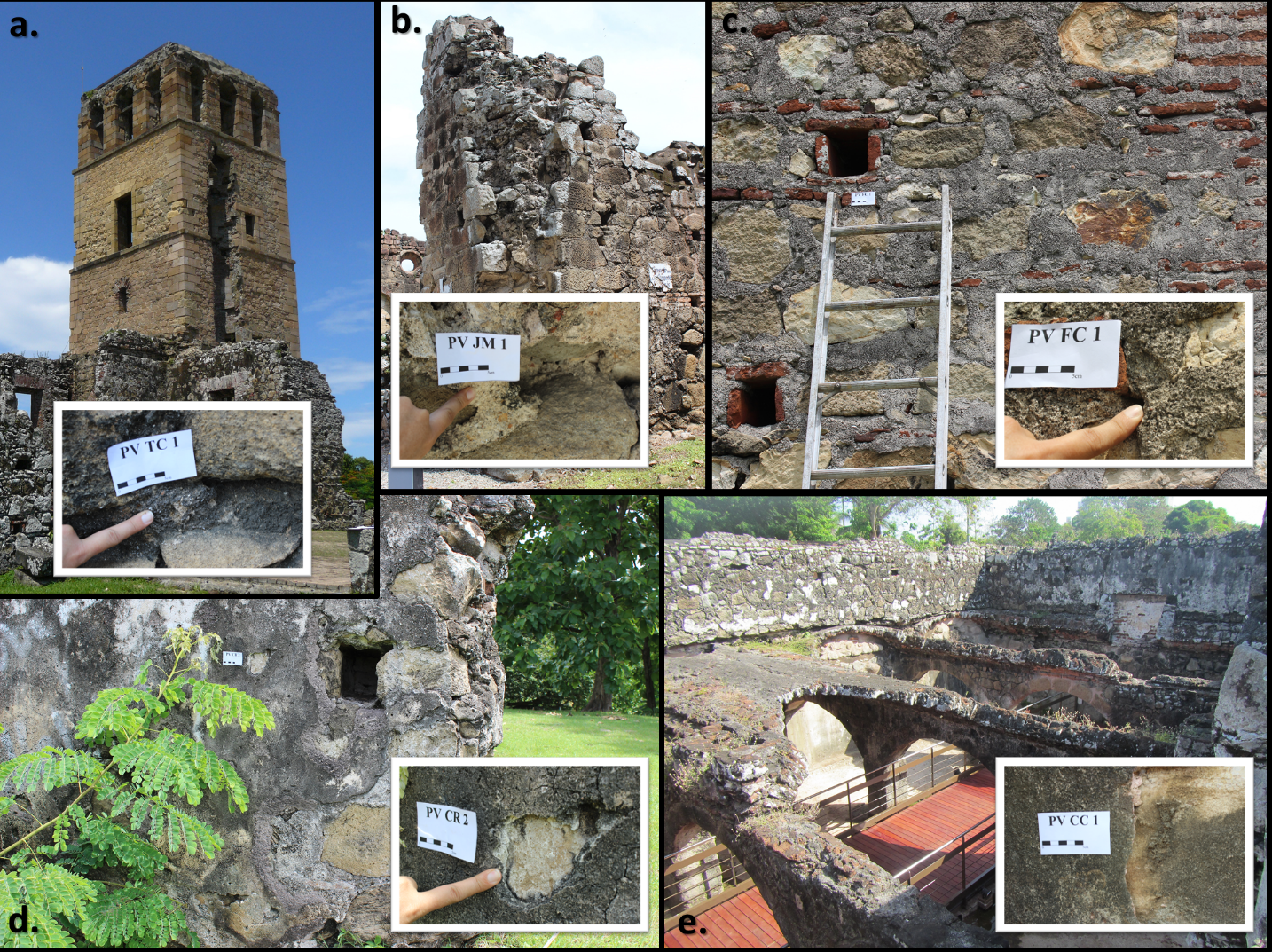CA detailed study, devoted to the characterization of the mortars belonging to the UNESCO site of Panamá Viejo is here presented. The monumental site is located in Panama City (Panama) and it represents the first Spanish settlement on the Pacific Coast, founded 500 years ago, in 1519.
- mortars
- plasters
- central America heritage
- Spanish colonial architecture
- world heritage
1. Introduction
The Archaeological Site of Panamá Viejo (or Old Panama), also known as the “Panamá Viejo Historical Monument Complex (note: Archaeological Site of Panamá Viejo1” is the official name of the site, used internationally; nevertheless, the “Monumental Complex of Panamá Viejo” is the nationally used name by law)”is paart of the World Heritage property named the “Archaeological Site of Panamá Viejo and Historic District of Panama”. It arises on a prosperous territory, where archaeological studies revealed that the first human’s settlements date back to more than a thousand years ago. During the XVI century, the Panamanian isthmus became a crucial crossroad for commercial routes between the “New World” and the “Old World”. Consequently, Panamá Viejo was founded in 1519, and it is the oldest European settlement on the Pacific coast of the Americas. Abandoned in the mid-17th century, during its existence, it was affected by fire and an earthquake, and it was definitely destroyed during a pirate attack in 1671. After this, several materials of the buildings of Panamá Viejo were used to construct a new settlement closer to the Ancón Hill, the currently named “Casco Antiguo”, or the “Historic District of Panama"” [1].
Nevertheless, the remains and the original layout of this exceptional historical site are still visible nowadays. Its current location and map are reported in Figure 1.

Figure 1. Modified satellite imagery of Panama (Sources: Esri, HERE, Garmin, FAO, NOAA, USGS, © OpenStreetMap contributors, and the GIS User Community, Sources: Esri, USGS) and, in the detail, of the Archaeological Site of Panamá Viejo (Earthstar Geographics powered by Esri, from https://whc.unesco.org, Copyright © 1992 – 2022 UNESCO/World Heritage Centre. All rights reserved.)
2. Construction Ttechniques and Eenvironmental Ccontext
In Panamá Viejo, natural stone started to be used in the masonry construction around the end of the XVI century, and it was utilized only for government buildings, churches, convents, and in the finest houses.
All the available documentation on the Panamanian buildings, from the 16th century until the end of the colonial era, underlined the existence of three types of construction: entirely built in wood; entirely built in stonework; and another one, a mixed type, with the first floor in stone and the upper floor in wood [2] [2].
The masonries still visible nowadays belong to the stonework and mixed typologies; the majority of which were built or re-built after a disastrous earthquake occurred in 1621.
Considering the provenance of the possible raw materials utilised for constructing the stonework, it can be affirmed that they come from the Panamanian territory, as supported by previous onstudies [2][3][2,3]. In addition, a literature investigation of the environmental context of the site area was performed; in particular, focusing on the geology of the area and the climatic conditions these materials are exposed to [4][5][6][7][8][9][10] [4,5,6,7,8,9,10].
In conclusion, the ait m of this work is to characterize the composition and to evaluate the state of conservation of the mortars, which are exposed to a warm and humid climate and embedded in a rather congested metropolis. Furthermore, it wathe authors addressed the integration of their previously conducted studies, at the Panamá Viejo Complex, on the characterization of stone building materials and the evaluation of impacts due to climate change [11][12][11,12].
3. Characterization of the Mortars
Within the Panama Viejo Historical Monument Complex, seven monuments were selected in order to analyse the mortars utilised, specifically the following ones: Fortín de la Natividad (FN); Convento de la Merced (CM); Convento de San Francisco (FC); Compañía de Jesús (JM); Aljibe (alias cistern) del Convento de la Concepción (CC); Casas Reales (CR); Torre de la cathedral (TC) [11][13][14][11,13,14]. Furthermore, five samples from previous archaeological excavations have been analysed, too [15][16][15,17].
The majority of the samples are bedding and joint mortars, followed by plasters and two masonry mortars showing traces of a finishing layer on the external surface. In addition, two samples belonging to the pavements from previous archaeological excavations and one from the pavement of the cistern of the Convento de la Concepción have been included in this study [15][16][15,17].
Several pictures of the monuments sampled and of some specimens collected are reported in Figure 2.

Figure 2. Images and macro-pictures of some sampled monuments: a. Torre de la Catedral, joint mortar; b. Compañía de Jesús, joint mortar; c. Convento de San Francisco, joint mortar/repointing mortar; d. Casas Reales, plaster; Aljibe del Convento de la Concepción, plaster.
During the sampling campaign, a preliminary macro-observation for evaluating the state of conservation of these materials was realized. The majority showed an alteration probably ascribable to biological colonization, exhibiting a dark-grey black or greenish aspect of the surface. Furthermore, materials loss, thin cracks, and powdering were also detected [17][16].
Minero – petrographic characterization was carried out by polarized light microscopy (PLM) observations of thin-sections of the mortars, which subsequently underwent to a more detailed morphological and microchemical investigation by Environmental Scanning Electron Microscopy (ESEM-EDS) [18][19][18,19]. Along with this investigation, specific samples were selected according to their representativeness and the adequate material amount for performing X-Ray Powder Diffraction analysis (XRPD) in order to identify the crystalline phases [20][21][20,21].
Considering the bedding/joint mortars, analyses revealed that they can be both classified as fat and lean mortars [22]. Among them, two samples present scarce and almost absent aggregate; however, they show residual fossils/shells (for example,.g. foraminifera, echinoderms and so on, etc.) and lumps, as remnants of burning stone (under-burnt) and fragments of over-burnt stone (used for lime’s production), are observed in almost all samples. This factor can indicate an inhomogeneous distribution of the temperature within the kiln and/or a difficult calcination of the stone. Furthermore, these lumps are also often characterised by fissuring due to shrinkage [19][22][23][24][19,22,23,24].
All the samples studied can be attributable to lime-based mortars, presenting a brownish colour, often inhomogeneous. The aggregate is largely formed by both carbonate and silicate fragments. The carbonate fraction is represented by fragments of bioclasts (as foraminifera, bivalves, echinoderms and so on, etc.), with rounded/subrounded shapes and dimensions varying between tens/hundreds to thousands of microns, probably ascribable to the use of the beach sand. Nevertheless, the use of local rocks, such as polygenic breccias, which show the presence of these fossils, cannot be excluded [11][12][11,12]. Considering the silicate fraction, generally, altered volcanic rock fragments, quartz, plagioclases, pyroxenes are detected, with the sporadic presence also of micas and zeolites. They mostly present sub-rounded shapes (rock fragments) and angular/sub-angular shapes (single minerals). With the exception of the zeolites, indeed, these latter ones are usually present within amygdales as secondary minerals. Furthermore, the presence of iron oxides is largely observed.
Figure 3 shows some examples of thin section of joint mortars observed under PLM.

Figure 3. PLM micrographs of joint mortars, both in parallel-polarised light (ppl) and cross-polarised light (xpl), showing: a. (xpl) rest of several fossils, including echinoderms (highlighted by red arrows); b. rest of an echinoderm (highlighted by red arrow); c. (xpl) lump with dissolution and fissuring (highlighted by red arrow), presence of carbonate (cb) and silicate fragments (highlighted with the name “Silica” and by yellow arrows) within the aggregate; d. (xpl) detail of the aggregate formed by sub-rounded shell fragments (cb) and silicate fraction, mainly formed by pyroxenes (cpx) [25][30].
Regarding the plasters, they are lime based, without aggregate. With the exception of the one used on the internal wall of the cistern, indeed, in this case, cocciopesto fragments were identified in order to give hydraulicity to the material [24][26][24,26]. Finally, the mortars belonging to the pavements, both from previous archaeological excavations and from the cistern, show scarce binder, whereas the nature of aggregate is similar to the one described for the masonries’ mortars.
These results agree with a previous onestudy, which characterized samples from the Torre de la Cathedral and evaluated their state of conservation [27][25]. Indeed, thits research work analysed two plasters and two embedding/jointing mortars, classifying them as lime mortars with heterometric rests of carbonated fossils, from marine or fluvial sand and fragments of volcanic rocks. Moreover, plagioclases, pyroxenes (for example,e.g. augite), quartz, and iron oxides were detected. Finally, the mortars showed the presence of iron oxides and high porosity. This latter one, is diffusely observed also in the majority of the samples here presented, indeed micro-investigations revealed pores and fissures/cracks, some of them showing the crystallization of secondary minerals as calcite. The precipitation of calcite is observed also near the external surface of two specimens.
One of them, specifically the plaster from the cistern, presents a further outer altered layer, rich in iron oxides, which also reveals the presence of brushite, a hydrated calcium phosphate, detected by XRPD investigation. The presence of phosphorous is also confirmed by ESEM-EDX. This compound could be due to a reaction of phosphate-rich solutions (probably deriving from the presence of guano) with calcite and clay derived from the soil that in the past buried the area [15][28][15,29].
PLM and ESEM-EDS micrographs showing some examples of plaster specimens observed are reported in Figure 4.

Figure 4. Micrographs showing: a. PLM (xpl) of plaster sample, the calcite finishing layer shows an irregular and porous surface, rich in dissolution and recrystallization phenomena. Presence of carbonate fraction (Cb) within the aggregate; b. PLM (ppl) of plaster sample, collected from the cistern, showing the external altered layer. A fragment of cocciopesto is highlighted by a white arrow. The secondary calcite, re-crystallized within the interface between the mortar and the external layer, is more evident under the ESEM microscope c., where also the presence of iron and phosphorus is detected by EDS maps (analyzed area is indicated by the rectangle, with dashed line, within b. and c.).
Finally, by naked eye, several specimens presented a superficial blackening, an alteration that could be due to the presence of a cyanobacteria, called “alga negra” (Oscillatoria sp.), also observed on the surface of the stone masonries [11]. Its presence can be responsible for an aesthetic damage, in addition to representing a substrate for further biological deterioration and water retention [11][29][30][11,27,28].
4. Final Rremarks
In conclusion, the mortars analysed were obtained utilizing local rocks, both for the carbonate and for the silicate fraction of the aggregate, and for producing the lime binder. The majority of the samples shows a similar composition; nevertheless, it is not possible to state that these mortars belong to the same intervention and so to the same period, as the site and the monuments underwent several modifications during the 16th and 17th centuries. Finally, their state of conservation is quite poor, exhibiting evidence of alteration due to dissolution phenomena (as the secondary calcite within pores and on the surface), diffused porosity, and the presence of biodeterioration, as a result of the high moisture to which these materials are exposed. The characterization of the original materials and their weathering and decay processes is necessary for choosing the most compatible products for their proper restauration [31]. Therefore, this information can support the regular maintenance and the restoration works performed by the Patronato Panamá Viejo, which aims to preserve and enhance the tangible and intangible features of this unique place.
This entry is adapted from 10.3390/heritage5020036
